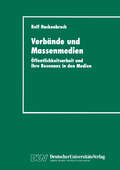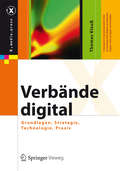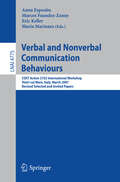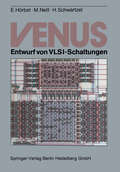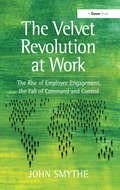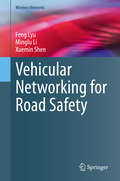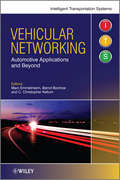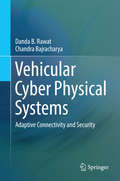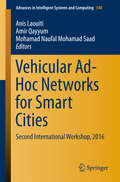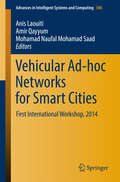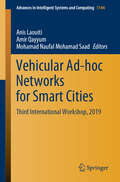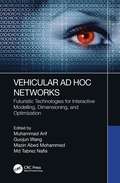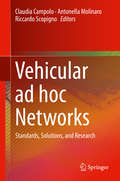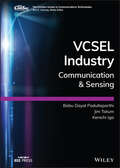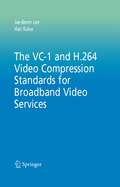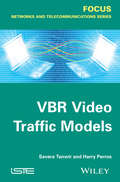- Table View
- List View
Verbände und Massenmedien: Öffentlichkeitsarbeit und ihre Resonanz in den Medien
by Rolf HackenbrochDer Autor zeigt die wachsende Bedeutung der Öffentlichkeitsarbeit für die Lösung anstehender Probleme und die Relevanz massenmedialer Kommunikation für die Verbandsarbeit auf.
Verbände digital: Grundlagen, Strategie, Technologie, Praxis (X.media.press)
by Thomas Klauß„Verbände digital“ gibt einen fundierten Überblick über die wichtigsten, für das Thema relevanten Bereiche, beschreibt praxiserprobte Konzepte und konkrete Lösungen für die digitale Verbandsmodernisierung. Eine Besonderheit sind die 10 wertvollen Beispiele unterschiedlicher Verbände, in denen ihre digitalen Modernisierungsmaßnahmen und die damit verbundenen Erfahrungen aus erster Hand beschrieben werden. Das Buch ist das einzige Kompendium, in dem alle wichtigen Bereiche digitaler Verbandsarbeit anwendungsorientiert behandelt werden. Den Schwerpunkt bilden Maßnahmen interner und externer Verbandskommunikation, Multi Channel Kommunikations- und Contentmanagement, digitale Services, Inhouse- und Cloud-Lösungsmodelle, Dokumenten- und Wissensmanagement sowie digitale Zusammenarbeit. In diesem Zusammenhang werden auch praktische Hilfen zu Datenschutz und Datensicherheit und Fragen zu Organisation, Kultur, Strukturen und Prozessen abgehandelt. Abgerundet wird das Inhaltsspektrum mit einer groß angelegten Studie zur Digitalen Verbandentwicklung, die 2010 und 2013 im Vergleich durchgeführt wurde. Das Fachbuch schließt mit einem Ausblick auf die zukünftige Entwicklung der Verbände.
Verbal Reasoning Practice Papers 2: For 11+, Pre-test And Independent School Exams Including Cem, Gl And Iseb
by Chris PearsePractice exam papers to prepare children for the most challenging pre-tests and 11 plus independent school entrance exams. Practice Papers 2 includes eight levelled exam papers that will test pupils' skills in verbal reasoning for a better chance of getting into the school of choice.
The Verbal Behavior Approach: How to Teach Children with Autism and Related Disorders
by Mary Lynch BarberaThe Verbal Behavior (VB) approach is a form of Applied Behavior Analysis that is based on B.F. Skinner's analysis of verbal behaviour. In this book Barbera draws on her experiences as a Board Certified Behavior Analyst and also as a parent of a child with autism to explain VB and how to use it.
Verbal and Nonverbal Communication Behaviours: COST Action 2102 International Workshop, Vietri sul Mare, Italy, March 29-31, 2007, Revised Selected and Invited Papers (Lecture Notes in Computer Science #4775)
by Anna Esposito Marcos Faundez-Zanuy Eric Keller Maria MarinaroThis book constitutes the thoroughly refereed post-proceedings of the COST Action 2102 International Workshop on Verbal and Nonverbal Communication Behaviours held in Vietri sul Mare, Italy, in March 2007. The twenty six revised full papers presented together with one introductory paper comprise carefully reviewed and selected participants’ contributions and invited lectures given at the workshop. The papers are organized in topical sections.
Verantwortungszuschreibung im Journalismus: Responsibility Framing von Depressionen und Diabetes mellitus aus Kommunikator*innenperspektive
by Annemarie WiedickeDie Art und Weise, in der wir als Gesellschaft mit Gesundheit und Krankheit umgehen, wird maßgeblich durch Fragen der (Eigen-)Verantwortung geprägt: Wer ist verantwortlich dafür, dass ein Mensch erkrankt? Die Person selbst, ihr soziales Umfeld, oder strukturelle Gegebenheiten? Und wessen Aufgabe ist es, das entstandene Problem zu beheben? Wie oder wem Menschen gesundheitliche Verantwortung zuschreiben, wird nicht zuletzt durch das Framing in der journalistischen Berichterstattung beeinflusst. Einem interdisziplinären Ansatz folgend beleuchtet dieses Buch die Responsibility Frames in der Berichterstattung und ihren Entstehungsprozess – das Responsibility Frame Building. Am Beispiel von Depressionen und Diabetes mellitus werden mittels einer Kombination von Inhaltsanalyse und Leitfadeninterviews die mediale Darstellung von Verantwortung im Gesundheitskontext, die krankheitsspezifischen Vorstellungen von Journalist*innen sowie die individuellen, organisatorischen und externen Einflüsse auf die Berichterstattung beleuchtet. Die Befunde liefern einen wichtigen Einblick in Frame Building Prozesse in der journalistischen Nachrichtenproduktion. Dabei zeigt sich, dass Journalist*innen eine zentrale Rolle für die mediale Zuschreibung gesundheitlicher Verantwortung zukommt.
Verantwortliche Unternehmensführung überzeugend kommunizieren: Strategien für mehr Transparenz und Glaubwürdigkeit
by Bernd Lorenz WalterDas Spannungsfeld zwischen dem Gewinnstreben und der Moral ist die zentrale Herausforderung der modernen Unternehmens- und Markenkommunikation. Besonders vor dem Hintergrund der aktuellen Bemühungen von Unternehmen, gesellschaftlichen Ansprüchen durch eine verantwortliche Unternehmensfürhung gerecht zu werden, gewinnt dieser Aspekt an Bedeutung. Dieses Buch gibt einen umfassenden Überblick über die Kommunikation verantwortlicher Unternehmensführung mit vielen praktischen und wissenschaftlich fundierten Tipps zur Umsetzung.
Veranstaltungskommunikation
by Christoph GronebergIn diesem Band wird aus medien- und kommunikationswissenschaftlichen, ingenieurwissenschaftlichen, philosophischen, geographischen oder rechtlichen Perspektiven, von Standpunkten des Veranstaltungs-, Verkehrs- und Social Media-Managements sowie aus feuerwehrlichen Überlegungen heraus Veranstaltungskommunikation thematisiert, denn: Kommunikation ist die Schnittstelle zwischenmenschlicher Interaktion. Ob im Alltag oder in krisenhaften oder katastrophischen Ausnahmesituationen ist sie eines der Mittel zur Herstellung von Sicherheit. Dies gilt auch und gerade im Kontext von Großveranstaltungen.
The Velvet Revolution at Work: The Rise of Employee Engagement, the Fall of Command and Control
by John SmytheWhat drives or delivers engaged people? Employers need to focus on creating the right conditions. Employers can't impose engagement: people need to choose to engage themselves. In The Velvet Revolution at Work, the follow-up to his best-selling The CEO: Chief Engagement Officer, John Smythe explains that the essential ingredient of the right conditions is a culture of distributed leadership which enables people at work to liberate their creativity to deliver surprisingly good results for their institution and themselves. Using models, examples and anecdotes from his client research he goes on to demonstrate exactly how to design an engagement process; one that is integrated with your business strategy and that is sustainable.
The Velvet Revolution at Work: The Rise of Employee Engagement, the Fall of Command and Control
by John SmytheWhat drives or delivers engaged people? Employers need to focus on creating the right conditions. Employers can't impose engagement: people need to choose to engage themselves. In The Velvet Revolution at Work, the follow-up to his best-selling The CEO: Chief Engagement Officer, John Smythe explains that the essential ingredient of the right conditions is a culture of distributed leadership which enables people at work to liberate their creativity to deliver surprisingly good results for their institution and themselves. Using models, examples and anecdotes from his client research he goes on to demonstrate exactly how to design an engagement process; one that is integrated with your business strategy and that is sustainable.
Vehicular Networking for Road Safety (Wireless Networks)
by Feng Lyu Minglu Li Xuemin ShenThe topics addressed in this book are crucial for both the academic community and industry, since the vehicular network has become an essential building block for intelligent transportation systems. The systematic principle of this book provides valuable guidance on the deployment and implementation of V2X-enabled road-safety applications. In addition, this book carries out structured technologies from the MAC layer to the link and network layer, which can provide a general introduction for interested readers with a comprehensive understanding of applying vehicular networks in enhancing road safety, and offers a systematized view for researchers and practitioners in the field of vehicular networks to help them optimize and improve the desired vehicular communication systems.Road safety has always been the first priority for daily commuters on the road. Vehicular networks can be an effective solution to enhance road safety, via which vehicles can exchange cooperative awareness messages rapidly, contributing to better situation awareness and maneuvering cooperation. However, with the fast-changing network topology, intermittent wireless link, and dynamic traffic density, it is challenging to achieve satisfying network performance.This book introduces the background of vehicular networks, provides a comprehensive overview of networking techniques in supporting road-safety applications, states the technical motivations per the MAC, link, and network layer, and proposes/designs vehicular networking technologies at the corresponding layer respectively to guarantee low-latency and reliable V2X communications for road-safety applications. By extending the proposed networking technologies to support all types of vehicular services, this book also outlines open issues and research directions in future 5G and beyond vehicular networks.
Vehicular Networking: Automotive Applications and Beyond (Intelligent Transport Systems #2)
by Marc Emmelmann Bernd Bochow Christopher KellumDuring the last 15 years, the interest in vehicular communication has grown, especially in the automotive industry. Due to the envisioned mass market, projects focusing on Car-to-X communication experience high public visibility. This book presents vehicular communication in a broader perspective that includes more than just its application to the automotive industry. It provides, researchers, engineers, decision makers and graduate students in wireless communications with an introduction to vehicular communication focussing on car-to-x and train-based systems. Emphasizes important perspectives of vehicular communication including market area, application areas, and standardization issues as well as selected topics featuring aspects of developing, prototyping, and testing vehicular communication systems. Supports the reader in understanding common characteristics and differences between the various application areas of vehicular communication. Offers both an overview of the application area and an in-depth discussion of key technologies in these areas. Written by a wide range of experts in the field.
Vehicular Cyber Physical Systems: Adaptive Connectivity and Security
by Danda B. Rawat Chandra BajracharyaThis book provides probabilistic, deterministic and geolocation-aware approaches for adaptive connectivity, robust security and privacy-aware communications for vehicular cyber physical systems (CPS). It presents mathematical models and numerical results obtained from experiments and simulations, and a trade-off between connectivity, security and privacy for vehicular communications.Connectivity between vehicles is crucial for vehicular CPS. Intelligent vehicular CPS provides not only road safety and traffic efficiency by exchanging information among vehicles, but also offers infotainment services to passengers using a variety of wireless technologies to forward the traffic/trajectory information with Vehicle-to-Vehicle (V2V), vehicular ad hoc network (VANET), and Vehicle-to-Roadside-to-Vehicle (V2R2V) communications. The book covers how to ensure that the message received from other vehicles is secure and trustworthy, rather than malicious. Further, it reveals how to make sure that the privacy of participants is not revealed while validating the received message. Researchers and professionals working with vehicular networks, smart systems, cyber physical systems, and mobile privacy will find this book valuable.
Vehicular Ad-Hoc Networks for Smart Cities: Second International Workshop, 2016 (Advances in Intelligent Systems and Computing #548)
by Anis Laouiti Amir Qayyum Mohamad Naufal Mohamad SaadThis book presents selected articles from the Second International Workshop on Vehicular Adhoc Networks for Smart Cities, 2016 (IWVSC’2016). In order to promote further research activities and challenges, it highlights recent developments in vehicular networking technologies and their role in future smart cities.
Vehicular Ad-hoc Networks for Smart Cities: First International Workshop, 2014 (Advances in Intelligent Systems and Computing #306)
by Anis Laouiti Amir Qayyum Mohamad Naufal Mohamad SaadVehicular communication is a key technology in intelligent transportation systems. For many years now, the academic and industrial research communities have been investigating these communications in order to improve efficiency and safety of future transportation. Vehicular networking offers a wide variety of applications, including safety applications as well as infotainment applications. This book highlights the recent developments in vehicular networking technologies and their interaction with future smart cities in order to promote further research activities and challenges.SAADI BOUDJIT, University of Paris 13, France HAKIMA CHAOUCHI, Telecom SudParis, France YACINE GHAMRI, University La Rochelle, FranceHALABI HASBULLAH, Universiti Teknologi Petronas, MalaysiaANIS LAOUITI, Telecom SudParis, France SAOUCENE MAHFOUDH, Jeddah, Saudi Arabia PAUL MUHLETHALER, INRIA, FranceAMIR QAYYUM, Mohamad Ali Jinnah University, PakistanNAUFAL SAAD, Universiti Teknologi Petronas, MalaysiaAHMED SOUA, NIST, USAHAJIME TAZAKI, University of Tokyo, JapanAPINUN TUNPAN, Aintec, ThailandWEI WEI, Xi'an University, ChinaRACHID ZAGROUBA, ENSI, Tunisia.
Vehicular Ad-hoc Networks for Smart Cities: Third International Workshop, 2019 (Advances in Intelligent Systems and Computing #1144)
by Anis Laouiti Amir Qayyum Mohamad Naufal Mohamad SaadThis book presents selected papers from the Third International Workshop on Vehicular Ad-hoc Networks for Smart Cities, Paris, 2019. Future smart cities are well placed to profit from extraordinary mobile infrastructures. IWVSC'2019 brings together experts from both academia and industry to discuss recent developments in vehicular networking technologies and their interaction with future smart cities in order to promote further research activities and challenges.
Vehicular Ad Hoc Networks: Futuristic Technologies for Interactive Modelling, Dimensioning, and Optimization
by Muhammad ArifWith the evolution of technology and sudden growth in the number of smart vehicles, traditional Vehicular Ad hoc NETworks (VANETs) face several technical challenges in deployment and management due to less flexibility, scalability, poor connectivity, and inadequate intelligence. VANETs have raised increasing attention from both academic research and industrial aspects resulting from their important role in driving assistant system. Vehicular Ad Hoc Networks focuses on recent advanced technologies and applications that address network protocol design, low latency networking, context-aware interaction, energy efficiency, resource management, security, human-robot interaction, assistive technology and robots, application development, and integration of multiple systems that support Vehicular Networks and smart interactions. Simulation is a key tool for the design and evaluation of Intelligent Transport Systems (ITS) that take advantage of communication-capable vehicles in order to provide valuable safety, traffic management, and infotainment services. It is widely recognized that simulation results are only significant when realistic models are considered within the simulation tool chain. However, quite often research works on the subject are based on simplistic models unable to capture the unique characteristics of vehicular communication networks. The support that different simulation tools offer for such models is discussed, as well as the steps that must be undertaken to fine-tune the model parameters in order to gather realistic results. Moreover, the book provides handy hints and references to help determine the most appropriate tools and models. This book will promote best simulation practices in order to obtain accurate results.
Vehicular Ad Hoc Networks: Futuristic Technologies for Interactive Modelling, Dimensioning, and Optimization
by Muhammad Arif Guojun Wang Mazin Abed Mohammed Tabrez NafisWith the evolution of technology and sudden growth in the number of smart vehicles, traditional Vehicular Ad hoc NETworks (VANETs) face several technical challenges in deployment and management due to less flexibility, scalability, poor connectivity, and inadequate intelligence. VANETs have raised increasing attention from both academic research and industrial aspects resulting from their important role in driving assistant system. Vehicular Ad Hoc Networks focuses on recent advanced technologies and applications that address network protocol design, low latency networking, context-aware interaction, energy efficiency, resource management, security, human-robot interaction, assistive technology and robots, application development, and integration of multiple systems that support Vehicular Networks and smart interactions. Simulation is a key tool for the design and evaluation of Intelligent Transport Systems (ITS) that take advantage of communication-capable vehicles in order to provide valuable safety, traffic management, and infotainment services. It is widely recognized that simulation results are only significant when realistic models are considered within the simulation tool chain. However, quite often research works on the subject are based on simplistic models unable to capture the unique characteristics of vehicular communication networks. The support that different simulation tools offer for such models is discussed, as well as the steps that must be undertaken to fine-tune the model parameters in order to gather realistic results. Moreover, the book provides handy hints and references to help determine the most appropriate tools and models. This book will promote best simulation practices in order to obtain accurate results.
Vehicular ad hoc Networks: Standards, Solutions, and Research
by Claudia Campolo Antonella Molinaro Riccardo ScopignoThis book presents vehicular ad-hoc networks (VANETs) from the their onset, gradually going into technical details, providing a clear understanding of both theoretical foundations and more practical investigation. The editors gathered top-ranking authors to provide comprehensiveness and timely content; the invited authors were carefully selected from a list of who’s who in the respective field of interest: there are as many from Academia as from Standardization and Industry sectors from around the world. The covered topics are organized around five Parts starting from an historical overview of vehicular communications and standardization/harmonization activities (Part I), then progressing to the theoretical foundations of VANETs and a description of the day-one standard-compliant solutions (Part II), hence going into details of vehicular networking and security (Part III) and to the tools to study VANETs, from mobility and channel models, to network simulators and field trial methodologies (Part IV), and finally looking into the future of VANETs by investigating alternative, complementary communication technologies, innovative networking paradigms and visionary applications (Part V). The way the content is organized, with a differentiated level of technical details, makes the book a valuable reference for a large pool of target readers ranging from undergraduate, graduate and PhD students, to wireless scientists and engineers, to service providers and stakeholders in the automotive, ITS, ICT sectors.
VDI-Lexikon Informatik und Kommunikationstechnik (VDI-Buch)
by Manfred Broy Otto SpaniolDas erfolgreiche Lexikon ist wieder auf dem aktuellen Stand. Von den führenden Wissenschaftlern der Informatik bearbeitet, bietet es anschauliche und verständliche Informationen zur Informatik und Kommunikationstechnik.
VCSEL Industry: Communication and Sensing (The ComSoc Guides to Communications Technologies)
by Babu Dayal Padullaparthi Jim Tatum Kenichi IgaA hands-on reference to the technical, commercial, and industrial aspects of VCSEL technology In VCSEL Industry: Communication and Sensing, a team of distinguished researchers and manufacturing professionals deliver a thorough and practical reference guide to vertical-cavity surface-emitting lasers (VCSELs) for young entrepreneurs, investors, venture capitalists, and researchers. The authors offer comprehensive descriptions of the technology involved, as well as a robust exploration of the industry and commercial landscape in which VCSELs exist. In VCSEL Industry: Communication and Sensing, distinguished researchers and manufacturing professionals Dr. Padullaparthi Babu Dayal, Dr. Jim A Tatum and Prof. Kenichi Iga deliver a thorough and practical reference guide to vertical-cavity surface-emitting lasers (VCSELs) for young entrepreneurs, investors, venture capitalists, and researchers. The authors offer comprehensive descriptions of the technology involved, as well as a robust exploration of the industry and commercial landscape in which VCSELs exist. The book contains numerous illustrations and schematics of the anatomy of VCSEL product developments and an insightful discussion of the proliferation of VCSELs in photonics and optics. There is also a dedicated section on photoreceivers used for VCSEL-based data communications and sensing. VCSEL Industry: Communication and Sensing provides readers with an accessible, commercial perspective of an important technology while offering just enough technical detail to make sense of the subject. The book also includes: A thorough introduction to VCSELs, including discussions of semiconductor lasers, materials, wavelengths, and why VCSELs are attractive for photonics applications Comprehensive explorations of the VCSEL industry, including market demands, an industry landscape, descriptions of commercial products based on VCSELs, and business models Practical discussions of VCSELs for data communication, including high-speed VCSELs, gain and parasitic effects on bandwidth and speed, and form factors and standards In-depth examinations of VCSEL arrays for sensing, including high-power VCSELs in consumer electronics Perfect for early-career researchers, engineers, entrepreneurs, investors, and managers, VCSEL Industry: Communication and Sensing will also prove to be an invaluable addition to the libraries of executives from across the semiconductor industry.
VCSEL Industry: Communication and Sensing (The ComSoc Guides to Communications Technologies)
by Babu Dayal Padullaparthi Jim Tatum Kenichi IgaA hands-on reference to the technical, commercial, and industrial aspects of VCSEL technology In VCSEL Industry: Communication and Sensing, a team of distinguished researchers and manufacturing professionals deliver a thorough and practical reference guide to vertical-cavity surface-emitting lasers (VCSELs) for young entrepreneurs, investors, venture capitalists, and researchers. The authors offer comprehensive descriptions of the technology involved, as well as a robust exploration of the industry and commercial landscape in which VCSELs exist. In VCSEL Industry: Communication and Sensing, distinguished researchers and manufacturing professionals Dr. Padullaparthi Babu Dayal, Dr. Jim A Tatum and Prof. Kenichi Iga deliver a thorough and practical reference guide to vertical-cavity surface-emitting lasers (VCSELs) for young entrepreneurs, investors, venture capitalists, and researchers. The authors offer comprehensive descriptions of the technology involved, as well as a robust exploration of the industry and commercial landscape in which VCSELs exist. The book contains numerous illustrations and schematics of the anatomy of VCSEL product developments and an insightful discussion of the proliferation of VCSELs in photonics and optics. There is also a dedicated section on photoreceivers used for VCSEL-based data communications and sensing. VCSEL Industry: Communication and Sensing provides readers with an accessible, commercial perspective of an important technology while offering just enough technical detail to make sense of the subject. The book also includes: A thorough introduction to VCSELs, including discussions of semiconductor lasers, materials, wavelengths, and why VCSELs are attractive for photonics applications Comprehensive explorations of the VCSEL industry, including market demands, an industry landscape, descriptions of commercial products based on VCSELs, and business models Practical discussions of VCSELs for data communication, including high-speed VCSELs, gain and parasitic effects on bandwidth and speed, and form factors and standards In-depth examinations of VCSEL arrays for sensing, including high-power VCSELs in consumer electronics Perfect for early-career researchers, engineers, entrepreneurs, investors, and managers, VCSEL Industry: Communication and Sensing will also prove to be an invaluable addition to the libraries of executives from across the semiconductor industry.
The VC-1 and H.264 Video Compression Standards for Broadband Video Services (Multimedia Systems and Applications #32)
by Jae-Beom Lee Hari KalvaThis book covers the MPEG H.264 and MS VC-1 video coding standards as well as issues in broadband video delivery over IP networks. This professional reference is designed for industry practitioners, including video engineers, and professionals in consumer electronics, telecommunications and media compression industries. The book is also suitable as a secondary text for advanced-level students in computer science and electrical engineering.
VBR Video Traffic Models (Focus Ser.)
by Savera Tanwir Harry G. PerrosThere has been a phenomenal growth in video applications over the past few years. An accurate traffic model of Variable Bit Rate (VBR) video is necessary for performance evaluation of a network design and for generating synthetic traffic that can be used for benchmarking a network. A large number of models for VBR video traffic have been proposed in the literature for different types of video in the past 20 years. Here, the authors have classified and surveyed these models and have also evaluated the models for H.264 AVC and MVC encoded video and discussed their findings.
